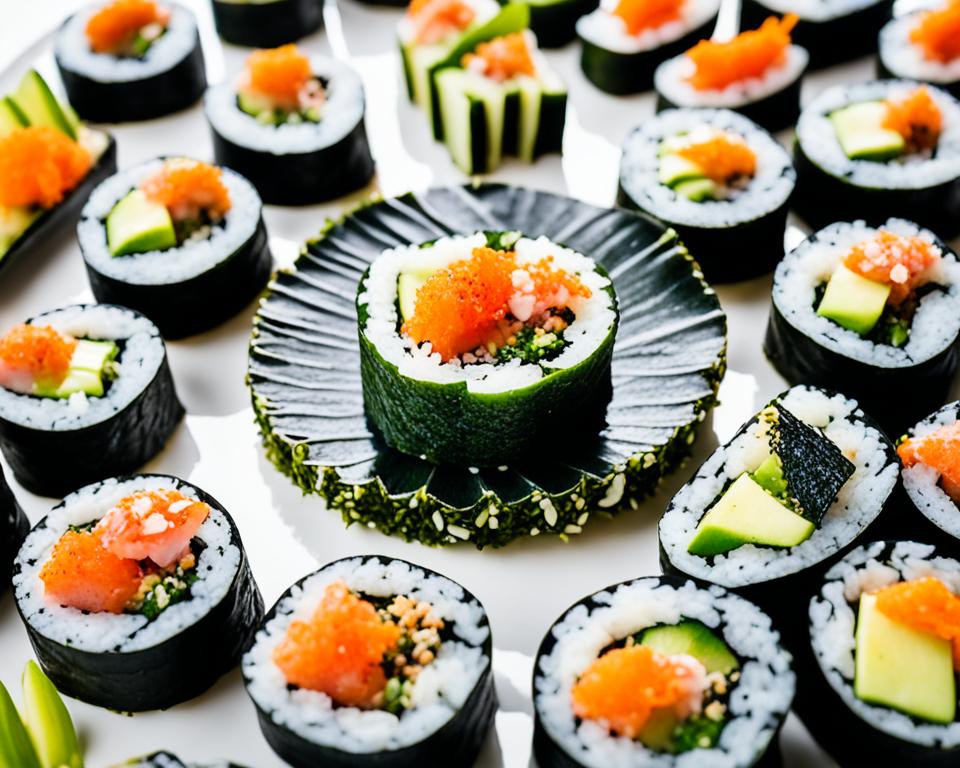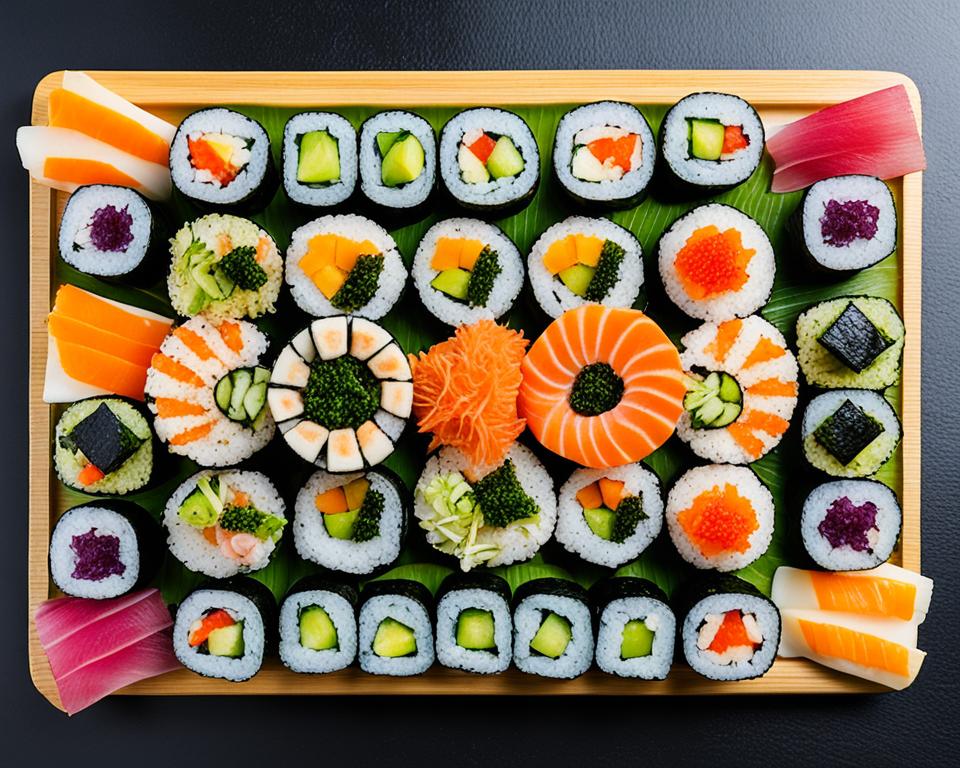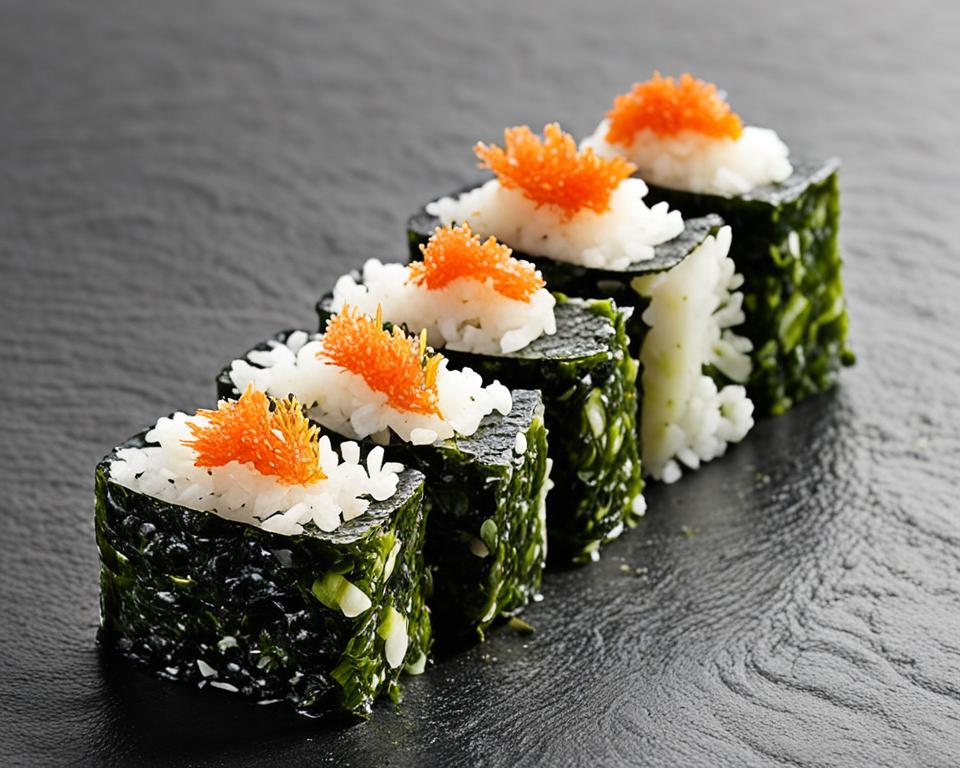Nori sushi is a key part of Japanese cuisine and is loved globally. This guide will take you into the world of nori sushi. We’ll look at its history, what it’s made of, how it’s prepared, and its cultural importance. By the end, you’ll understand why nori sushi is a favorite around the world.
Read interesting things at : info-kirara
Key Takeaways
- Nori sushi is a traditional Japanese dish made with seaweed wrap, sushi rice, and various fillings.
- The history of sushi dates back centuries, with nori sushi becoming a popular variation in the 19th century.
- Nori seaweed is the foundation of nori sushi, providing a distinctive flavor and texture.
- Properly prepared sushi rice is the backbone of nori sushi, requiring specific techniques and seasonings.
- Nori sushi offers a wide range of fillings, from seafood favorites to vegetarian options.
Introduction to Nori Sushi
Nori sushi is a well-loved symbol of Japan’s rich food culture. It’s famous for its unique round shape, made from nori seaweed. This sushi variety, known as makizushi, has won over people all over the globe.
What is Nori Sushi?
Nori sushi includes a layer of nori seaweed that surrounds a mix of tasty fillings. These might be seafood, veggies, or other delicious items. This blend creates a beautiful, tasty sushi roll.
A Brief History of Sushi
Sushi-making dates back to ancient times in Japan. Originally, it was a way to keep fish fresh. It has since grown into the refined dish we enjoy today. In the 8th century, sushi began with fish wrapped in vinegared rice, leading to today’s diverse sushi types.
“Sushi is an art form, a beautiful and delicate expression of Japanese culture and tradition.”
Eventually, as Japan’s food became known worldwide, nori sushi stood as a key part of its culinary history. It found fans far beyond Japan.
Nori Seaweed: The Foundation
The heart of nori sushi is the nori seaweed. It is versatile and packed with flavor. This seaweed is harvested from Japan’s coasts. It’s then dried and roasted, which gives sushi its unique taste and serve as a wrapper.
Nori, used in nori sushi, is a key part of Japanese cuisine. People have been harvesting and eating seaweed since the 8th century. Now, nori is carefully grown, dried, and roasted to get its dark green color and crispy texture.
- Nori isn’t just for wrapping. It also adds flavor to sushi.
- The drying and roasting bring out nori’s rich umami taste.
- Nori’s smell and texture make sushi more interesting.
“Nori is the foundation that holds the sushi together, both literally and figuratively. Its unique flavor and texture are integral to the essence of nori sushi.”
This seaweed is crucial for nori sushi. It doesn’t just look nice; it makes sushi taste great. Nori is a must-have for sushi, showing its strong tie to Japanese cuisine.
Sushi Rice: The Backbone
Nori sushi’s main secret is its rice, rich yet simple. This short-grain Japanese rice is key, bringing the perfect level of stickiness and taste. Cooking and seasoning the rice is vital to sushi, setting up its famous textures and flavors.
Preparing Sushi Rice
Making sushi rice starts with picking the right short-grain rice from Japan. This rice is chosen for its sticky texture that’s needed. It’s then cooked right and seasoned with rice vinegar, sugar, and salt, creating an amazing taste.
After seasoning, the rice is spread out to cool. This step is important for keeping the grains separate and with their own special texture. It helps get the rice to the perfect firm-but-soft feel that sushi is known for.
Importance of Seasonings
Flavoring the rice is key in making great nori sushi. The mix of rice vinegar, sugar, and salt adds a unique sweetness and tang. This flavor combines perfectly with other sushi fillings, uniting them into a great taste.
Getting the seasonings just right ensures every bite of sushi is full of flavor. The skill in balancing these flavors is what makes Japanese sushi preparation stand out. It shows how seriously they take their culinary craft.
“The secret to great sushi lies in the rice. It’s the foundation upon which all other flavors and textures are built.”
– Jiro Ono, renowned sushi master
Nori Sushi Fillings
Nori sushi comes in many fillings, meeting different tastes and dietary needs. It includes classic seafood like tuna and salmon. Yet, it also boasts fresh vegetarian choices. This variety lets anyone enjoy the wonders of Japanese food.
Seafood Favorites
Seafood is a key part of nori sushi. It features favorites such as tuna and shrimp. These not only taste great but are also good for you. The mix of seaweed and seafood brings out the best flavors.
Vegetarian Options
For plant lovers, nori sushi has many options. Choices like avocado and cucumbers are refreshing. And pickled veggies add both taste and health benefits. For something hearty, there are mushrooms and more, meeting many diets.
Your choice of fillings changes the taste and health of your sushi. Whether you love seafood or the veggie options, nori sushi’s flexibility shines. It’s a great way to dive into Japanese cuisine.
| Seafood Fillings | Vegetarian Fillings |
|---|---|
| Tuna | Avocado |
| Salmon | Cucumber |
| Shrimp | Mushrooms |
| Crab | Pickled Vegetables |
“Nori sushi is a canvas for culinary exploration, letting us mix diverse flavors. This celebrates true Japanese cuisine.”
Makizushi: The Art of Rolling
In the world of nori sushi, makizushi is a captivating technique. It turns ordinary ingredients into stunning dishes. Sushi chefs and home cooks love this skill. They enjoy creating beautiful pieces through layering and shaping.
Rolling Techniques
To master makizushi, you need patience, precision, and attention to detail. Sushi rolling starts with well-prepared rice. The rice is seasoned and cooled before use. The cook then adds fillings, like seafood or veggies, in a line on the nori. They roll it tightly with a bamboo mat, making a neat cylinder.
Rolling demands careful steps. After the first roll, the chef shapes and tightens the sushi. They finally cut it into small, perfect pieces. This process shows the balance needed between the rice, fillings, and nori.
Mastering makizushi shows the chef’s expertise and celebrates Japanese cuisine. Creating sushi isn’t just about looks. It’s about infusing flavors and textures that delight anyone who tastes it.
“Sushi rolling is a dance between the chef’s hands and the ingredients, a delicate interplay that transforms the ordinary into the extraordinary.”
Are you into sushi or new to makizushi? Sushi rolling is an exciting journey. It dives deep into Japanese cuisine and the dedication chefs have to their craft.
Nori Sushi Varieties
Nori sushi comes in many delicious forms for all tastes. You can find everything from the famous California roll to unique specialty rolls. This shows the creativity and variety of nori sushi.
The California roll is always a hit. It has imitation crab, avocado, and cucumber, all rolled up in nori and rice. Many sushi lovers first try nori sushi through this tasty roll.
Looking for something new? Try specialty nori sushi rolls. They mix things like spicy tuna, tempura shrimp, or grilled eel, showing off nori sushi’s endless options in Japanese cuisine.
Don’t eat meat? There are great options for vegetarians and vegans in nori sushi. The avocado roll and the cucumber roll are favorites. They are flavorful and perfect for anyone looking for a meat-free treat.

Do you like traditional or new sushi? Seafood or vegetarian? The world of nori sushi varieties has something for everyone. Each roll is a unique blend of tastes and looks, showing the true beauty and creativity of Japanese sushi.
Nori Sushi: Healthy Snack
Nori sushi isn’t just tasty; it’s a super nutritious snack. The main part, nori seaweed, is packed with vitamins, minerals, and antioxidants. The sushi rice adds complex carbs, and the fillings give you key nutrients. Adding nori sushi to your meals brings a taste of Japan with balance and nutrition.
Nutritional Benefits
Nori, the seaweed wrap, is full of good stuff. It’s rich in iodine for a healthy thyroid and metabolism. Plus, it has lots of vitamins A, C, and B12, along with minerals like iron and calcium. These help with your immune system, bones, and overall health.
Sushi rice is a complex carb, so it fuels you steadily and offers essential nutrients. B vitamins in the rice help turn your food into energy. With fillings like seafood, veggies, or proteins, nori sushi becomes a complete, nutritious snack.
“Nori sushi is not only a delicious treat but also a surprisingly healthy option for those looking to incorporate more Japanese cuisine into their diet.”
Eating nori sushi means enjoying Japan’s flavors in a nutritious way. It’s great as a fast snack or a full meal. Nori sushi is adaptable and good for your health in general.
Pairing Nori Sushi
Nori sushi is a favorite Japanese dish. It comes with various condiments that make the meal special. Trying different traditional and new flavors can make you love it even more.
Condiments and Accompaniments
The key to enjoying nori sushi is having the right condiments. Soy sauce, with its rich flavor, lets you adjust the taste. Wasabi, a strong Japanese horseradish, adds a pop to the meal. Pickled ginger refreshes your taste buds between bites.
Japanese cuisine also offers great pairings for nori sushi. Miso soup has a savory broth that matches well. Edamame, with sea salt, gives a nice crunch to complement the sushi.
| Condiment/Accompaniment | Flavor Profile | How it Pairs with Nori Sushi |
|---|---|---|
| Soy Sauce | Deep, umami-rich | Enhances the flavors of the sushi, allowing diners to customize the taste |
| Wasabi | Pungent, spicy | Provides a delightful contrast to the mild rice and nori |
| Pickled Ginger | Tangy, refreshing | Cleanses the palate, preparing the taste buds for the next bite |
| Miso Soup | Savory, umami-rich | Balances the flavors of the nori sushi, creating a harmonious dining experience |
| Edamame | Crisp, lightly salted | Provides a satisfying crunch and refreshing counterpoint to the sushi |
Trying different nori sushi pairings is exciting. From classic condiments to surprising choices, there’s a lot to love in Japanese cuisine.
Nori Sushi: A Culinary Delight
Nori sushi pulls you into the world of Japanese food like a magic spell. It’s more than just eating. It’s about the beauty, the careful work, and Japan’s deep love for sushi. Every part, from the fine ingredients to how it’s made and served, brings joy to eating.
The key to nori sushi is special nori seaweed and just-right sushi rice. Adding in a mix of fresh and yummy things makes a great blend. It’s a party in your mouth!
Rolling sushi, or makizushi, is real craftsmanship. Chefs roll nori, rice, and fillings with skill. These rolls are like tasty pieces of art.
Eating nori sushi is like stepping into Japan’s food history. It’s more than a meal; it’s a way to see and feel Japan’s love for its food. You get to know a culture that values nature and traditions.
“Nori sushi is not just a meal, but a masterful fusion of flavors, textures, and cultural significance that captivates the senses and nourishes the soul.”
Enjoy it in a sushi bar or make it at home; nori sushi is special. It celebrates the beauty and culture of Japanese cuisine. It’s a delightful journey into the heart of nori sushi.

Presentation and Plating
How nori sushi looks is key to how we enjoy it. Chefs carefully arrange the sushi and its side bites. This makes every plate not just a meal but a work of art. It shows their deep respect for tradition and craft in Japan’s food culture.
The look of nori sushi is about mixing colors, textures, and garnishes right. They jazz up the dish with stuff like pickled ginger and shredded nori. Also, each sushi slice is placed with care for a beautiful and balanced plate.
They also use special Japanese trays for serving. These trays tell a story and add to the dish’s cultural weight. It’s a way to honor not only the food but its background too.
The way the sushi is arranged can enhance how you enjoy each bite. It guides when and how you eat the different pieces. This lets diners savor amazing flavor blends and textures throughout the meal.
The way nori sushi is presented does a lot more than look good. It makes eating it an exploration of flavors and textures. Chefs aim to make every plate a doorway to Japan’s culinary art and history.
“The true essence of sushi is not just the fish or the rice, but the entire experience – the way it is presented, the way it is eaten, and the way it makes you feel.” – Jiro Ono, renowned sushi chef
Etiquette for Eating Nori Sushi
Eating nori sushi from Japan is not just about the taste. You also need to observe specific manners to show respect. Learning and following these rules can make your dining experience with nori sushi even more special.
For nori sushi etiquette, the way you use chopsticks is key. It’s important to be gentle with them. Aggressive movements might mess up the sushi. Also, dip the sushi lightly in soy sauce, not the rice side.
Sushi dining etiquette covers how you eat the sushi too. Try to eat each piece in one go. This lets the flavors mix perfectly. Eating it in parts or heavily saucing it isn’t ideal.
Using hands to pick up sushi isn’t common, unless the place says it’s okay. Being graceful while eating shows you respect the nori sushi tradition.
By keeping to these rules, you get to enjoy and respect the beauty of Japanese sushi. It’s about valuing the chef’s work and traditional flavors in every single piece of nori sushi.
Making Nori Sushi at Home
Creating your own homemade nori sushi isn’t just for professional chefs. Anyone willing to learn and have the right tools can enjoy making this Japanese cuisine at home. By following simple steps and practicing, anyone can taste Japan at home.
The secret to great homemade nori sushi is learning the basics. Use top-grade nori seaweed, the perfect sushi rice, and fresh fillings. This understanding helps you make sushi that’s as good as any top restaurant’s.
Gathering the Essentials
To start, gather these essentials for nori sushi:
- Nori seaweed sheets
- Short-grain sushi rice
- Rice vinegar, sugar, and salt for seasoning the rice
- A sharp knife or specialized sushi knife
- A bamboo sushi mat
- A selection of your favorite sushi fillings, such as raw fish, vegetables, or cooked proteins
Mastering the Sushi Rice
Great nori sushi begins with the rice. Cook the sushi rice as the package directs. Then, mix in rice vinegar, sugar, and salt. Let it cool and soak up the flavors.
Rolling and Shaping
With your rice and fillings prepared, let’s roll. Lay a nori sheet on the mat. Add rice in a thin layer, leaving a space at the top. Then, place your fillings in a line at the rice’s center. Roll the sushi using the mat. Wet the edge of the nori to seal it.
Slicing and Serving
Now, it’s time to slice your roll. Use a sharp knife to cut it into bite sizes. Place them on a plate and add any toppings you like. Now, enjoy your nori sushi made from scratch!
With practice, you can master sushi in your kitchen. Dive into homemade nori sushi and bring the taste of real Japan to your table.
“Sushi is an art form, and it’s a way of life. It’s not just food.” – Jiro Ono, renowned sushi chef
Conclusion
Nori sushi is more than just a dish. It’s a celebration of Japan’s culinary skills. Mixing tradition with new ideas, it shows a love for quality ingredients. This dish has won over people from different cultures. It gives us a taste of Japan’s rich food history.
Exploring nori sushi teaches us a lot. We learn about the perfect balance of flavors and textures. This journey shows us the key role of nori seaweed and the art of making sushi rice. It’s all about creating the ideal sushi roll.
Now, we say goodbye to our deep dive into nori sushi. But, we leave with a new love for Japanese cuisine and sushi. The things we’ve learned will push us to dig deeper into this food world. We’ll enjoy every bite and understand nori sushi’s cultural significance better in food lovers’ hearts.
